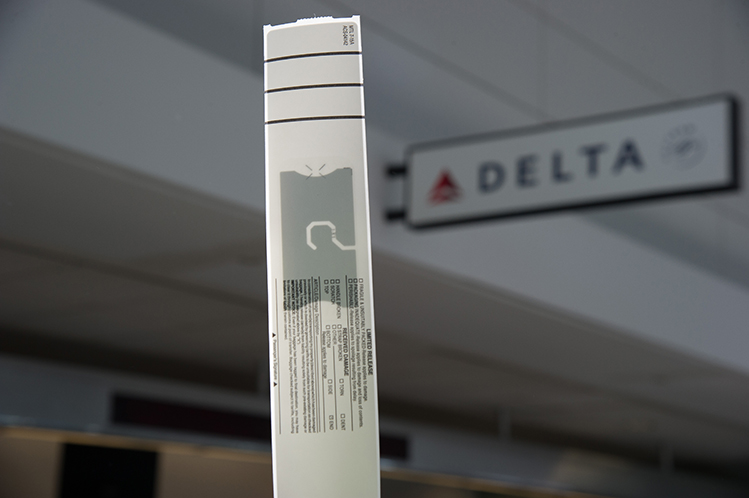By John Beasley, Airport Development Team Leader, Arup
As the volume of passengers passing through airports worldwide continues to rise and their expectations evolve, improving baggage-handling systems and processes remains high up on airport executives’ agendas.
Technological innovation is already beginning to transform some elements of the air travel experience: done well, self-service bag drops can almost eliminate queuing to check-in a bag, for example. But other aspects, such as baggage reclaim, have barely changed in decades, and customers are starting to expect more.

Real-time bag tracking is one concept with the potential to significantly enhance the traveller experience.
Traditional processes are undeniably inefficient and riddled with inconvenience – most continue to approach long check-in desk queues and lengthy waits around the baggage-carousel with dread. The scope to cut time, cost and remove unnecessary aggravation is clear.
So, what are some of the options? How can airport executives harness the latest technology and innovative thinking to improve baggage-handling and ultimately remain competitive?
Increased connectivity for passengers: Personalised real-time bag tracking
Real-time bag tracking is one concept with the potential to significantly enhance the traveller experience. Bags are still currently typically tracked via paper labels and scanned barcodes. This method has been the standard within the industry for many years, but it was designed for the needs of airlines and handlers in an era before passengers expected choice and unparalleled levels of service. Industry estimates put the number of bags handled each year at around 4 billion but, despite great improvements over the last 10 years, around 20 million bags a year are still not delivered on time for the passenger to collect.
Recent IATA initiatives are likely to have an impact here. A new resolution, 753, which became effective 1 June 2018, introduced new industry-wide standards for bag tracking. The resolution requires airlines to track baggage at four key points: passenger handover to airline, loading to aircraft, delivery to transfer area, and upon return to passenger. 100% compliance is not viable via barcode technology, so moving towards more advanced forms of tracking, such as Radio Frequency Identification (RFID), ought to be on airlines’ and airports’ agendas. These changes provide the opportunity to increase passenger control and connection to the baggage-handling process. Increased confidence in accurate baggage tracking is a key step to making this information more widely available directly to passengers. They would have reassurance that their luggage had been loaded safely, transported from aircraft to aircraft if on a transfer and then be able to ascertain wait times post-landing.
Uberisation of the baggage-handling process
Full Uberisation of the baggage-handling process – whereby bags are picked up and dropped off, from anywhere to anywhere, on demand – is another possibility that could be opened up by improved tracking systems. Services along these lines have already started to appear, but there is still a way to go, and further thinking needed before widescale adoption and use is viable. In particular there is a fundamental asymmetry between the departing and the arriving journeys. Passengers are able to drop off bags at different locations: the terminal, kerbside, downtown, and through collection services that pick-up luggage from hotels, offices and homes. In contrast, the arriving process is based on delivery to a reclaim in a terminal.
There are several reasons for this. First, arriving baggage is not always tracked – relying on being correctly loaded at an outstation. Second, there is not yet an accepted industry-wide method of capturing passengers’ delivery requirements. And third, inbound bags may be subject to security or customs checks.
But one can begin to see how some of these hurdles can be overcome. Improved tracking and RFID tags that encode much more information than a simple tag offer the opportunity to sort and deliver arriving baggage much more flexibly.
The commercial model also needs work. Improving ease of use is key and increased integration with airlines is arguably the simplest answer here. Allowing passengers to organise and pay for these kinds of services alongside tickets, all at once, would undoubtedly encourage more to book. A close alliance between airline and service provider would also allow the process to run more efficiently.
What are the benefits? Well, first and foremost, is the improved passenger experience. Imagine getting off a flight and simply having your bags delivered promptly to your home or hotel – no more anxious waiting at reclaim. And there are benefits for airports and airlines too. Reducing the space taken for reclaim could shrink the size of terminals, making them more cost-efficient.

Improved tracking and RFID tags that encode much more information than a simple tag offer the opportunity to sort and deliver arriving baggage much more flexibly. Photo credit: Delta
Looking ahead
The possibilities around baggage-handling are clear. What we now need is effective collaboration between airlines, airports, technology providers and regulators to bring tangible progress.
Improving systems here will have a huge impact on overall customer experience, and the airports and airlines that move fast will reap the benefits.







